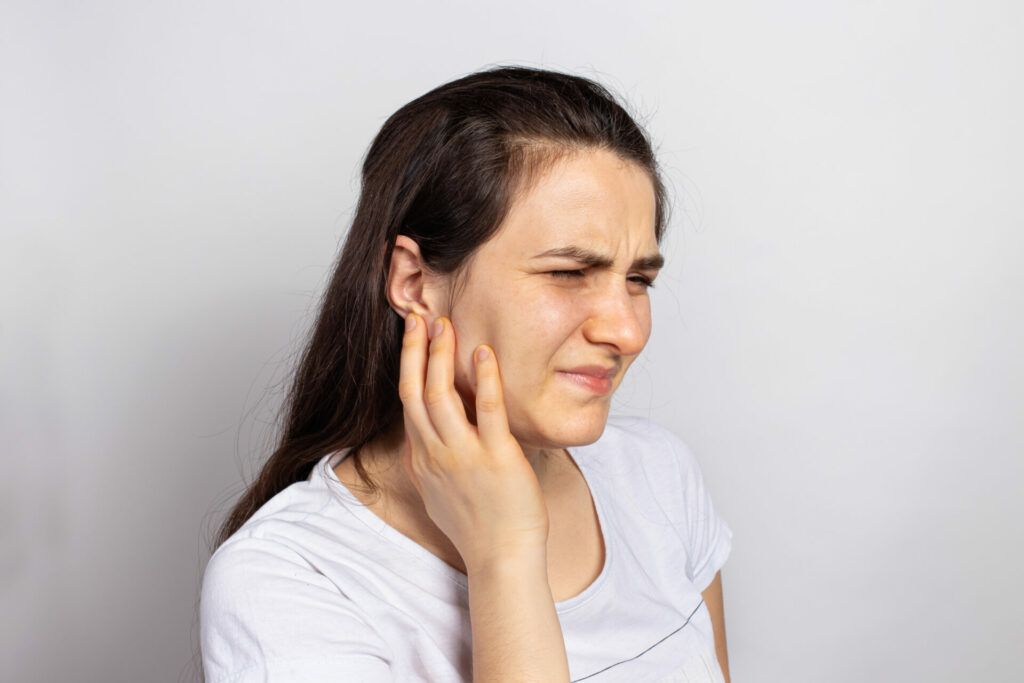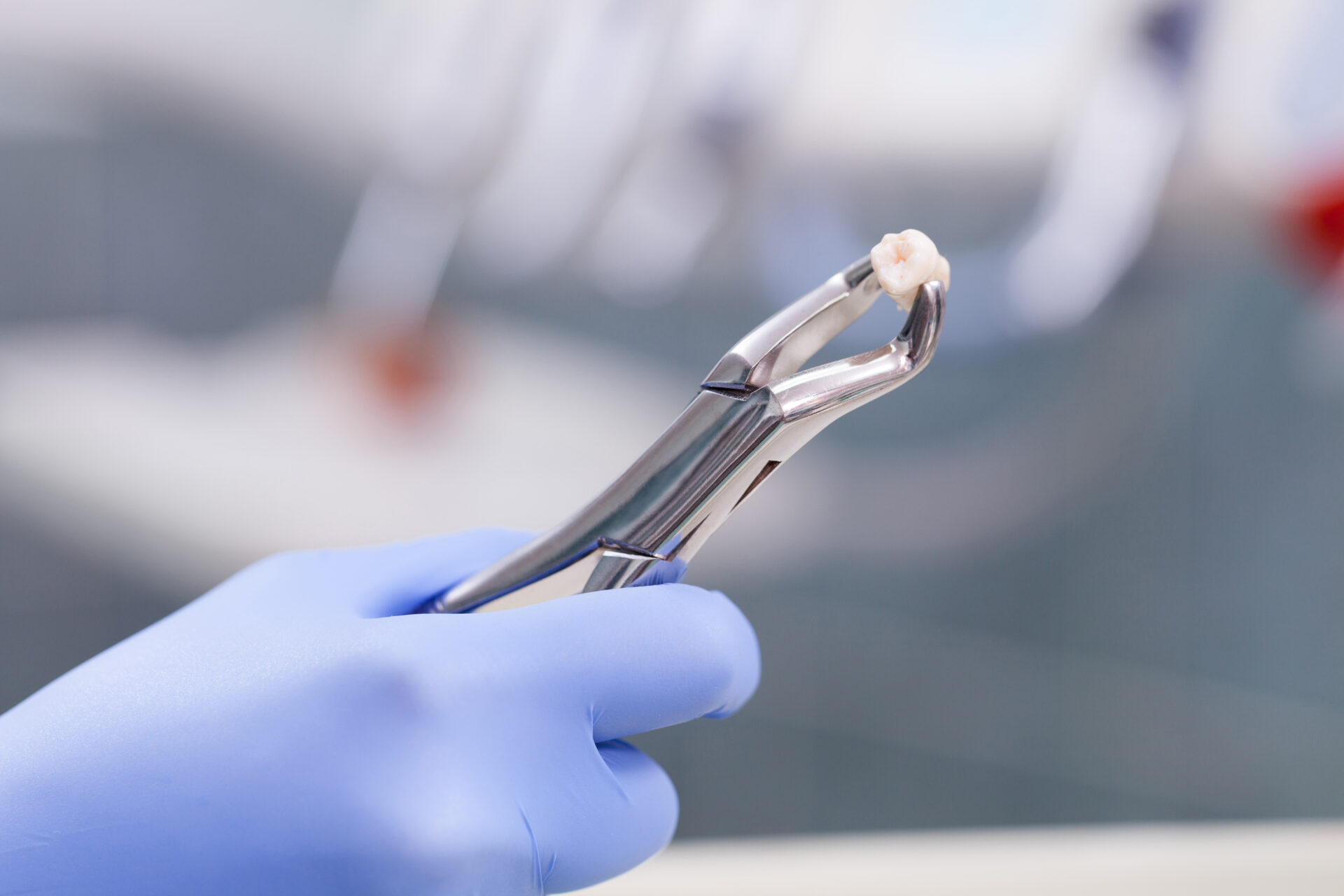74% of UK adults have had a tooth extraction at some point in their lives [1]. There are many reasons you may need a tooth removed, but the most common is tooth decay [2].
If you need a tooth extraction, you may be worried about potential pain during or after the procedure. In this article, we’ll discuss whether tooth extraction hurts, pain and side effects after having a tooth removed, and how to encourage speedy healing after surgery.
Does tooth extraction hurt?
Having a tooth removed without anaesthesia would be painful. Luckily, you will always receive some type of anaesthesia for a tooth extraction.
It’s normal to experience some pain afterwards at the site of the extraction. You’ll likely be prescribed pain medication for this or advised to take over-the-counter pain relief like ibuprofen. More than 50% of people find they need to take pain medication within the first week following a tooth extraction [3].
If you’re concerned about pain and side effects from a tooth extraction, contact our team for advice. Harley Street Specialist Hospital’s oral and maxillofacial consultants can create a holistic care plan with you to minimise pain and anxiety before, during and after the procedure.
Types of anaesthesia during tooth extraction
There are three different types of anaesthesia that your dentist or surgeon may use for a tooth extraction. Let’s look at each type in more detail:
Local anaesthesia
When local anaesthesia is used, you’ll be completely awake and aware throughout the procedure. You shouldn’t feel any pain, but you may feel pressure, pushing or pulling sensations in your mouth.
Before the extraction, your dentist or surgeon uses a numbing substance so you don’t feel the anaesthetic injection. Once this is applied, they give you one or more anaesthetic injections in the area of the tooth extraction. This type of anaesthesia is generally used for simple tooth extractions.
Sedation anaesthesia
Sedation anaesthesia allows you to stay awake for the procedure in a drowsy and relaxed state. You’ll be partially conscious, with limited memory of the procedure.
This type of anaesthesia is used if you are anxious about the procedure, or if the extraction is more complex than normal. Here are some different types of sedation anaesthesia:
- Pills or tablets can be taken before the procedure to make you feel calm and drowsy.
- Nitrous oxide (laughing gas) offers minimal sedation and helps you relax.
- Intravenous (IV) sedation can be given through a line in your arm. This offers a higher level of sedation than the other two options.
With each of these types of sedation anaesthesia, you will also receive local anaesthesia to numb the site of the extraction.
General anaesthesia
When you receive general anaesthesia, you will be completely unconscious and unaware of the procedure. You’ll need to avoid eating or drinking for several hours before having a general anaesthetic [4].
When you wake up, the procedure will be over. Your dentist or surgeon will likely give you local anaesthesia to help with any pain afterwards.
General anaesthesia is only used in specific circumstances for a tooth extraction. It’s given via an IV line in your arm, or by inhaling the medication through your nose. You may receive it via both methods at the same time.
While you’re unconscious during the procedure, your vital signs will be monitored. This includes your blood pressure, heart rate, breathing and temperature.
Pain after a tooth extraction
Although the anaesthesia should prevent you from feeling pain during your tooth extraction, pain is expected after the procedure. This is normal, and the length of recovery depends on which tooth was extracted.
For example, wisdom tooth removal is often more complex, so the pain may be more intense and last longer compared to other teeth. Molar teeth are the most frequently extracted, particularly first premolars due to orthodontic treatment [5].
How long does tooth extraction pain last?
Pain from a tooth extraction will usually fade within a week, although the healing process can take several weeks. The pain is usually most intense in the first 24-48 hours following surgery and should begin to ease after that.
What should I expect in the weeks following a tooth extraction?
Immediately after surgery, you may not feel any pain because the extraction site will be numb. You may feel some tingling as the local anaesthetic starts to wear off.
Within the first 24 hours, you may experience bleeding from the socket (extraction site) and higher levels of pain. This pain may be worse with activities that increase blood flow to your head, such as lying down or exercising.
In the next couple of days following this, you are still likely to experience some throbbing pain or aching around the socket. You may still have some bleeding from the socket during these days.
The level of pain you experience – and how long it lasts – is different for everyone. Other medical conditions, age, and how well you care for your mouth after surgery will all play a role.

Generally, the pain from a tooth extraction starts to resolve after three days. The extraction site will probably still feel sensitive and uncomfortable, but the bleeding should have stopped.
The hole left by your tooth may take several weeks or months to close completely. If you still have regular, intense pain a week after surgery, it’s worth contacting your dentist or surgeon for advice.
After a week, the blood clot in your socket should be fully formed and swelling should be reduced. Pain should be minimal, and the extraction site should not bother you much. 65.4% of people report having no pain at all by the seventh day post-surgery, and only 0.6% report having severe pain by this time [6].
Pain and side effects of tooth extraction
You may experience some uncomfortable symptoms after having a tooth removed, which usually resolve within a few days after the procedure. Here are some of the most common side effects:
Throbbing pain at the extraction site
This is a rhythmic pulse of dull pain, usually felt in and around the area of the extraction. This is a very common side effect of tooth extraction and should improve within a few days.
You may need pain medication to ease throbbing pain, which can be bought over the counter or prescribed by your dentist or surgeon. Contact your dentist or surgeon for advice if it doesn’t improve within a few days.
A blocked ear or ear pain
Tooth extraction can cause inflammation around your jaw and put pressure on your ears. You may experience buzzing, ringing, pain, mild hearing loss or a blocked sensation in the ear nearest the socket.
As the swelling improves in the first few days after surgery, these sensations should fade away. If it doesn’t improve or gets worse, seek medical advice, as this may be a sign of an infection.

Bad breath
After a tooth extraction, post-surgical bleeding and a dry mouth are common causes of bad breath. This should improve with time.
Neglecting to brush or floss your teeth after surgery can also cause bad breath due to an accumulation of food particles and bacteria. The bacteria can also cause serious infections.
Drink plenty of water and practise good oral hygiene to avoid bad breath after surgery. When 24 hours have passed after the extraction, you can return to brushing your teeth – with caution around the extraction site.
If your bad breath is getting worse or hasn’t improved after a few days, speak to your dentist or surgeon for advice.
Eye pain
Severe pain from a tooth extraction can radiate up to your eyes. Radiating pain is pain that spreads from one part of your body to another. If your pain is so severe that it’s making your eyes painful, it may be a sign of a more serious problem, such as a dry socket or an infection.
Dry socket is a medical condition that can occur after a tooth extraction – it describes what happens if the necessary blood clot doesn’t form, becomes lost or does not form well enough. This condition usually comes with intense pain.
Speak to your dentist or surgeon immediately if you are experiencing eye pain after a tooth extraction.
Sinus pain
You may experience sinus pain when you have an upper tooth removed. These teeth are close to the sinuses, and swelling from a tooth extraction can put pressure on them. There’s also the risk of tooth extraction opening a hole in the sinuses, which could cause further complications.
Try using anti-inflammatory medication or ice to relieve any sinus pain. The pain should resolve within a few days, but seek medical advice if it’s not improving or getting worse.
Nausea
You may feel sick after the procedure, especially if you’ve been sedated. This usually eases within a few hours, but sometimes the nausea can persist for several days.
Nausea lasting for days after tooth extraction is often due to factors other than sedation. You may be dehydrated, or it could be a side effect of your medication.
Drink plenty of water over the next 24 hours and if you continue to feel nauseous, it could be due to any medications you’re taking. Seek advice from the clinician who prescribed you the medication.
Sore jaw, throat or neck
Swelling from the tooth extraction site can spread to your jaw, throat and neck. It can also put pressure on all other nearby areas of your face. You may feel pressure or symptoms including burning, tingling, numbness or shooting pains if a nerve is compressed by swelling.
These symptoms should ease in a few days, although it may be a sign of infection if the lymph nodes on the sides of your neck feel swollen. See your dentist or surgeon if your pain worsens or does not resolve after a few days.
Around 5% of people will experience some type of complication following a tooth extraction, which rises to 7% if the tooth being removed is a wisdom tooth [7]. The most common complication is a wound infection, which affects 2% of people [7]. A broken jaw is a potential complication of wisdom tooth surgery but this is a rare complication.
How can I heal faster after a tooth extraction?
You can take steps at home to encourage a smooth healing process after a tooth extraction. Make sure also to follow any advice given by your dentist or surgeon following the procedure. Here are some tips to speed up recovery:
- When the first 24 hours have passed, you can start rinsing your mouth with salty water four times a day. Do this gently and use lukewarm water close to body temperature (37°C) mixed with salt.
- Avoid drinking alcohol and smoking for as long as possible after the surgery. At a minimum, this should be at least 24 hours.
- Brush your teeth gently (after the first 24 hours), keeping your toothbrush away from the extraction site. You can gradually start to brush closer to it over the next few days.
- Avoid rinsing out your mouth for the first 24 hours after the extraction. Rinsing too soon could disturb the blood clot and stop it from forming properly.
- Bite down on some clean material for at least 15 minutes if you experience any bleeding from the socket.
- Eat soft food in the first few days following the extraction to avoid disturbing the healing socket.
Tooth extraction at Harley Street Specialist Hospital
Our team of highly-trained oral and maxillofacial surgeons can offer rapid assessment and the latest treatment for your teeth. Video or telephone consultations from home are available when appropriate, and appointments can be arranged at a time convenient for you.
Book an appointment with Harley Street Specialist Hospital today to arrange a dental assessment and get the treatment you need.




